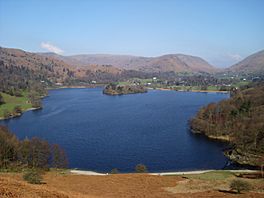Grasmere (lake) facts for kids
Quick facts for kids Grasmere |
|
|---|---|

View from Loughrigg Terrace, looking
across the lake towards Grasmere village |
|
| Location | Lake District, Cumbria |
| Coordinates | 54°26′56″N 3°01′15″W / 54.448834°N 3.020897°W |
| Primary inflows | River Rothay |
| Primary outflows | River Rothay |
| Basin countries | England |
| Max. length | 1680yd (1540m) |
| Max. width | 700yd (640m) |
| Surface area | 0.24mi² (0.62km²) |
| Max. depth | 70ft (21m) |
| Surface elevation | 208 ft (62m) |
| Islands | 1 |
Grasmere is a beautiful, smaller lake in England's famous Lake District. It is located in the county of Cumbria. The nearby village of Grasmere is named after the lake. This village is well-known because the famous poet William Wordsworth lived there.
Contents
Discover Grasmere Lake
Grasmere lake is about 1,540 meters (1,680 yards) long. It is also around 640 meters (700 yards) wide. The lake covers an area of 0.62 square kilometers (0.24 square miles).
Lake Depth and Water Flow
The deepest part of Grasmere is about 21 meters (70 feet). The lake sits 62 meters (208 feet) above sea level. The River Rothay flows into and out of Grasmere. This river first travels through Grasmere village. After leaving Grasmere, the river flows into nearby Rydal Water. From there, it continues its journey into Windermere.
Boating and Ownership
The Lowther Estate owns the water in Grasmere lake. They lease it to the National Trust. You can use private boats on the lake. You can also rent rowing boats. However, boats with motors are not allowed. This helps keep the lake peaceful and clean.
Grasmere Island and the National Trust
Grasmere lake has one island. It is known as Grasmere Island or simply The Island. This island has a special history.
The National Trust's Beginning
In 2017, Grasmere Island was given to the National Trust. This was a very important gift. The National Trust was actually started because of this very island! In 1893, the island was sold to a private buyer. Canon Hardwicke Rawnsley felt that such a beautiful place should be for everyone. He believed it should be owned by the public. Soon after, he helped start the National Trust. He worked with Octavia Hill and Robert Hunter to create this important organization.
What's in a Name?
The name "Grasmere" likely means "the lake flanked by grass." The word "gres" or "grass" and "mere" (meaning lake or pool) are the main parts of its name.



